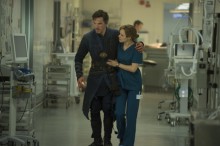At first glance, Doctor Strange looks like any other fun thing by Marvel about a comic-book superhero akin to Captain America or Iron Man. Stephen Strange (played by Benedict Cumberbatch) is a cynical but brilliant neurosurgeon, retired after a car accident and travelling to Nepal in search of healing. There he had found a guru (played by Tilda Swinton), devoid of any hair on her head. And then he discovers his supernatural powers, and began to fight evil in the astral dimensions. The majority of Marvel’s characters and scenes are purely materialistic – even those who are called “gods” (Thor and Loki, borrowed from the Scandinavian epic). Strange is perhaps the only one who kills his enemies with magic.
The dialogs, of course, are full of pathetic platitudes like: “If you go beyond your limitations – the power will lead you.” The excess of fighting scenes is somewhat balanced by really witty remarks and comic situations, as well as lavish special effects. But there is something else.
The comic about Strange was published in the 1960s. Everyone knows what that era was about: hippies, student riots, intense mystical self-search, which resulted either in various spiritual practices or experiments with hallucinogenic drugs. It quickly took shape in a certain kind of psychedelic aesthetics – both visual and musical. Among the brightest representatives of the latter were the mad British rock band Pink Floyd. The cover of their second album (A Saucerful of Secrets, 1968) depicts characters from the Strange comic book; one of the songs from the next album has the following lyrics: “And Doctor Strange is always changing size.” So, completely logical is the episode at the beginning of the film when Strange is getting ready for a party listening to a famous instrumental track of early “Floyds” – “Interstellar Overdrive.”
The writers brought something into the story for their own amusement (there is a momentary shot of the original comic’s author Stan Lee reading The Doors of Perception by Aldous Huxley – the manifest of psychedelic enlightenment), but the visual anarchism, which is absent in other Marvel titles should definitely not be attributed to Easter eggs. For example, the moments when the hero flies through the dizzying hallucinatory spaces and tunnels – and they last much longer than is necessary for the story; not to mention the streets and houses that are practically dancing in the fight scenes. The 1960s are called the era of childhood (hippies being the flowers’ children), and director is obviously trying to fill the film with the energy of those years.
Will Doctor Strange be the harbinger of lucid poetry in the purely functional world of movie comics? This is the most interesting question that arises after the final credits.








